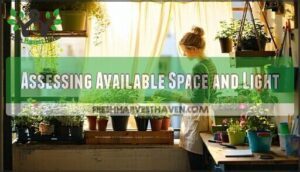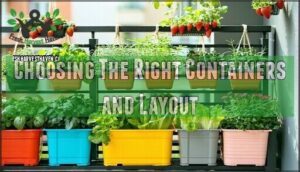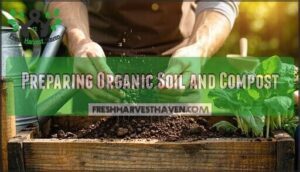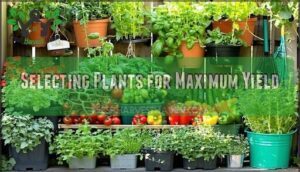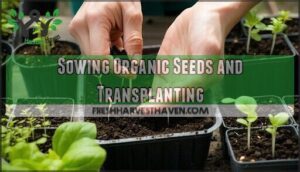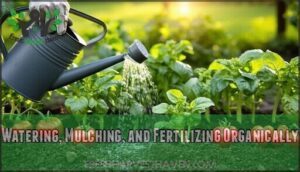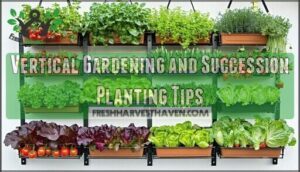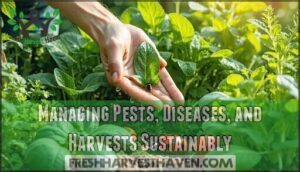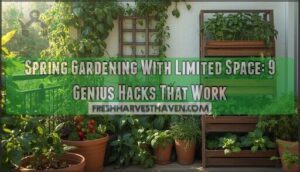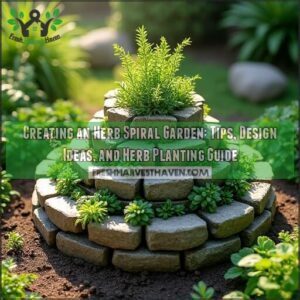This site is supported by our readers. We may earn a commission, at no cost to you, if you purchase through links.
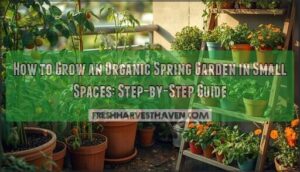
Start with containers that drain well, fill them with rich compost-based soil, and pick compact varieties bred for tight quarters.
Pair plants that help each other grow, and handle pests without chemicals.
Time your plantings right and stagger new seeds every few weeks—you’ll pull fresh harvests all spring and well into summer.
Table Of Contents
- Key Takeaways
- What Makes Gardening Organic?
- Planning Your Spring Garden in Small Spaces
- Selecting Plants for Maximum Yield
- Step-by-Step Organic Growing Methods
- Managing Pests, Diseases, and Harvests Sustainably
- Frequently Asked Questions (FAQs)
- What are the different types of small space gardening techniques?
- How to grow a garden in a small space?
- What is small space gardening?
- How do I get Started with small-space gardening?
- How do I create a garden in a small area?
- What can you grow in a small urban garden?
- What is the gardening 3 year rule?
- What are the easiest vegetables to grow in small spaces?
- What is the rule of 3 in gardening?
- How do I start a small organic garden?
- Conclusion
Key Takeaways
- Organic spring gardening in small spaces relies on container growing, quality compost, and vertical planting to transform balconies and patios into productive food sources without synthetic chemicals. – Success hinges on choosing appropriate containers, preparing nutrient-rich organic soil with compost and natural amendments, and selecting compact vegetable varieties that thrive in confined areas. – Companion planting paired with natural pest control methods creates a self-sustaining ecosystem that boosts yields, while strategic succession planting ensures continuous harvests throughout the season. – Even the smallest spaces can produce impressive results—proper planning with containers, organic soil preparation, and space-maximizing techniques can yield 40+ pounds of fresh produce from just 15 square feet.
What Makes Gardening Organic?
Organic gardening means growing food with natural methods, without synthetic fertilizers or pesticides. It focuses on healthy soil, sustainable practices, and caring for the plants, the earth, and you.
Definition and Principles of Organic Gardening
Have you ever wondered what makes a garden truly organic, beyond just skipping the synthetic stuff? Fundamentally, organic gardening means working with nature—using sustainable methods, caring for soil health, and boosting biodiversity benefits.
You’ll be growing without chemicals, sticking to organic farming methods, and following standards built to protect your harvest and the planet.
Examples of Organic Practices in Small Spaces
Once you know what organic gardening really means, it’s easier to spot the little habits that bring all those big ideas to life in even the smallest corners of your home.
From Container Composting under the sink to Vertical Farming along a balcony wall, Companion Planting, natural pest control, and prioritizing soil health all play an important role in practicing organic agriculture year-round.
Organic Certification and Food Labeling Basics
Sorting out organic certification and the USDA organic label can feel overwhelming, but it boils down to trust and traceability. Organic standards shape everything from Labeling Categories to fraud prevention, so check for the organic seal.
Understanding the USDA Organic guidelines ensures products meet specific standards. Regulatory updates tighten rules, and certification costs loom large, especially for smaller growers—so understanding Organic Labeling Regulations makes you a savvier, more empowered consumer.
Planning Your Spring Garden in Small Spaces
Getting your small space ready for an organic spring garden starts with a plan that matches your sunlight and square footage.
Simple choices about containers, layout, and soil set you up for healthy plants and big harvests, even on a balcony or patio.
Assessing Available Space and Light
You’ve got the organic basics down. Time to scout your space and see where each plant will actually succeed.
Start with environmental analysis: measure space, check sunlight direction through the day, and notice microclimates. Light requirements vary—observe shadows, test reflective surfaces, and assess soil composition.
Smart placement helps your organic garden thrive.
Choosing The Right Containers and Layout
With your space and sunlight sorted, let’s talk about picking containers and arranging your garden so everything grows where it thrives best. Sturdy, food-safe planters sustain organic matter and Soil Quality, while hanging baskets or shelves make vertical gardening a cinch.
Smart Layout Design—think aisles and groupings—fuels Space Optimization, securing organic gardening works even in the tightest corners.
Preparing Organic Soil and Compost
Got your containers sorted and space figured out? Now it’s time to build a foundation that actually nourishes your plants—starting with the right soil mix.
Organic matter like compost fuels nutrient cycling and microbial balance, turning lifeless dirt into a living ecosystem. Blend equal parts peat-free potting mix, compost, and perlite for drainage.
You can even brew compost tea to kickstart beneficial microbes—just steep finished compost in water for a few days, then strain and water your containers with it.
Selecting Plants for Maximum Yield
Even a cramped balcony or tiny patio can pump out fresh produce if you pick the right plants.
In this section, you’ll discover which vegetables, herbs, and pollinator-friendly flowers deliver the best results when space is at a premium.
Best Vegetables and Herbs for Small Areas
When choosing crops for urban gardening, focus on high yield varieties that thrive in containers. Leafy greens like lettuce and spinach deliver 3–5 kg per square meter, while compact tomato and pepper plants produce 5–15 pounds per plant in five-gallon pots.
For small space herbs, basil yields about 12 leaves weekly, and thyme requires minimal soil yet produces harvestable stems within 60 days. These organic products align with USDA organic label standards and aid healthy organic food production.
To make the most of space, consider using container gardening techniques for best growth.
Companion Planting and Space-Saving Varieties
Pairing the right plants together can double your harvest while cutting pest problems in half—a strategy that turns every square inch into a hardworking team. Try intercropping methods like tucking basil between tomatoes to repel aphids, or weaving lettuce under pole beans for natural shade.
Vertical gardens and compact varieties—think dwarf kale or bush cucumbers—let you stack layers without sacrificing organic farming practices or ecological balance.
Incorporating Flowers for Pollinators
Your smart plant pairings won’t mean much if you don’t have pollinators stopping by to help those blooms turn into actual food.
Tuck bee-friendly flowers like marigolds and calendula between your vegetables to create pollinator gardens that foster biodiversity and ecological balance.
Native blooms such as cosmos and sweet alyssum work as natural butterfly attractors while reinforcing organic farming practices.
These flower arrangements don’t just look nice—they’re essential partners in sustainable agriculture and organic food production.
Step-by-Step Organic Growing Methods
Now that you’ve mapped out your space and picked your plants, it’s time to get your hands dirty with organic methods.
This section walks you through the essential techniques—from starting seeds to keeping your garden thriving through the season.
Sowing Organic Seeds and Transplanting
With your plant selections ready to go, it’s time to get your hands dirty and start bringing seeds to life—whether you’re sowing directly into containers or nurturing seedlings indoors for later transplanting.
Choose certified organic seeds that match your climate and space. Start seeds in sterile, organic potting mix about six to eight weeks before your last frost date. Keep soil moist but not waterlogged, and provide plenty of light.
When seedlings develop their second set of true leaves and outdoor temperatures stabilize, harden them off gradually before transplanting into your prepared containers.
Watering, Mulching, and Fertilizing Organically
Keeping your plants properly hydrated, insulated, and nourished isn’t guesswork—it’s about building a rhythm that works with your space’s unique conditions. Water deeply but less frequently to encourage strong root systems, using organic irrigation methods like drip systems or soaker hoses.
- Apply organic mulch around plants to retain moisture and suppress weeds
- Feed with compost tea weekly during growing season for gentle nutrition
- Add natural fertilizers like fish emulsion or kelp meal every 2-3 weeks
Vertical Gardening and Succession Planting Tips
When every square inch counts, these two game-changing techniques can triple your harvest while keeping your garden growing from early spring through late fall. Vertical planters optimize space utilization through layered gardening systems that sustain organic food production year-round.
| Vertical Solutions | Succession Planting Schedule |
|---|---|
| Wall-mounted herb towers | Plant lettuce every 2 weeks |
| Tiered tomato cages | Stagger bean sowings monthly |
| Hanging basket gardens | Rotate seasonal crops quarterly |
| Trellis cucumber systems | Overlap cool/warm season varieties |
| Stackable container gardens | Plan continuous urban harvesting |
This approach transforms organic agriculture practices into productive urban harvesting systems.
Managing Pests, Diseases, and Harvests Sustainably
Protect your plants the natural way and pick at peak ripeness—that’s when spring gardens really shine.
Stay ahead of pests, trim when needed, and harvest strategically. Your small-space setup will keep producing all season long.
Natural Pest and Disease Control Strategies
Protect your small-space organic garden through strategic biological controls and eco-friendly methods that work with nature, not against it. Integrated management combines multiple organic farming practices to create sturdy defense systems against common threats.
- Biological Controls: Release ladybugs and lacewings to reduce aphid populations by 50-90%, while companion planting with marigolds and dill attracts natural predators that suppress pest damage.
- Organic Pesticides: Apply Bacillus thuringiensis for 95% cabbageworm control, or use neem oil-based solutions like Neemix 4.5 to reduce leaf damage while protecting beneficial insects.
- Disease Resistance: Choose disease-resistant varieties like powdery mildew-resistant cucumbers, which dramatically reduce pathogen losses compared to standard cultivars in organic food production systems.
Monitoring, Pruning, and Harvesting Techniques
After you set up those natural defenses, keeping plants healthy turns into something you just do—and it’s worth it.
Check leaves weekly for early disease signs, and prune damaged growth immediately to prevent spread.
Harvest timing matters—pick vegetables at peak ripeness for optimal nutrition and flavor.
Regular soil monitoring keeps your organic gardening on track through proper garden maintenance.
Maximizing Productivity and Seasonal Transitions
Getting more out of your garden takes some planning, but it’s not complicated. The right approach can help you harvest more food and keep your garden productive as seasons change. If you plant in waves instead of all at once, you can pull 50% more from the same space. Rotating what you grow where cuts soil depletion by 40% and keeps things healthy year-round. For extra harvests and healthier soil, think about weaving in some strategic companion pairings—this companion planting strategies guide for summer gardens dives into natural teamwork and smart crop partners.
- Succession Planting Strategy – Plant lettuce and radishes every 2-3 weeks so you’re always harvesting something fresh instead of dealing with feast-or-famine cycles.
- Seasonal Crop Rotation – Start with spinach in early spring, then switch to tomatoes when it warms up. Moving different plant families around keeps your soil in good shape.
- Space Optimization Techniques – Tuck fast growers like radishes between slower crops like peppers. You’ll get 30-40% more food per square foot and always have something ready to pick.
Frequently Asked Questions (FAQs)
What are the different types of small space gardening techniques?
You’ll discover that cramped quarters don’t cramp your style. Container gardening, raised beds, vertical planters, hydroponic systems, and micro gardening transform tight spaces into productive organic food production centers using advanced organic farming practices.
How to grow a garden in a small space?
Growing a garden in compact areas requires strategic space saving through vertical farming and container tips.
Urban gardening maximizes small plots using organic compounds like compost, following organic standards for sustainable food production.
What is small space gardening?
Small space gardening transforms tiny areas into productive growing zones using limited space solutions like container gardening benefits and vertical garden ideas.
Urban gardening yields often exceed traditional crop land productivity through intensive balcony garden design methods.
How do I get Started with small-space gardening?
Getting started with gardening is easier than you might think—it all begins by planting that first seed of inspiration.
Take a look at how much sun your space gets during the day and think about any size limits you might have.
After that, pick out some good pots or planters and get your soil ready—aim for rich, healthy dirt, and organic methods if you can.
How do I create a garden in a small area?
How can you transform a tiny balcony into a thriving garden? Start with vertical structures and space-saving designs.
Choose appropriate containers, prepare quality organic soil, and create favorable microclimates for sustainable food production.
What can you grow in a small urban garden?
From tiny apartment balconies to sprawling rooftops, urban spaces can yield surprising harvests through smart organic farming methods. Your container garden can produce dwarf varieties of tomatoes, peppers, and herbs alongside nutrient-packed microgreens that offer outstanding health benefits.
Balcony gardens using sustainable food production methods can achieve rooftop yields that rival traditional farming, making organic food production accessible to anyone with a few square feet of space.
- Cherry tomatoes in 5-gallon containers – dwarf varieties produce pounds of fruit
- Leafy greens and microgreens – fast-growing, high-nutrition powerhouses
- Compact herbs like basil and cilantro – fresh flavors year-round
- Edible flowers such as nasturtiums – beautiful and delicious additions
- Small root vegetables – radishes and baby carrots thrive in containers
What is the gardening 3 year rule?
Patience pays dividends in perennial gardening. The three-year rule states that plants "sleep" their first year, "creep" their second, and "leap" in their third year.
Your garden planning benefits from understanding organic cycles. New perennials direct energy underground during year one, building root systems rather than showy displays. This farm sustainability principle applies whether you’re growing herbs in containers or planning crop diversity.
Year two brings visible progress as plants establish. By year three, your patience rewards you with mature plants that’ll thrive for years.
This principle guides soil rotation decisions too—understanding how plants develop helps you create sustainable organic farming practices in any space.
What are the easiest vegetables to grow in small spaces?
When it comes to easy wins in the veggie patch, some crops are as dependable as old friends. Leafy greens, radishes, and herbs all take up little space but give you big, satisfying harvests—even if you’re just starting out.
Here are the champion Easy Grow Greens and vegetables for beginners:
- Lettuce and spinach – These Vertical Harvesting superstars mature in just 30-45 days
- Radishes – These Compact Root Crops are ready to harvest in 25 days
- Green beans – Bush varieties don’t need trellising and produce continuously
- Herbs like basil and parsley – Perfect for organic gardening newcomers
- Cherry tomatoes – Container-friendly and incredibly productive for Urban Farming Tips success
These organic food champions forgive mistakes while teaching you essential organic farming practices through hands-on experience.
What is the rule of 3 in gardening?
The rule of 3 in gardening refers to Garden Diversity principles. Plant in odd-numbered groups for visual appeal, rotate three different crop families annually for Soil Layers health, and use three-season Garden Planning for continuous harvests.
How do I start a small organic garden?
Getting your garden started is all about picking the right spot—some good sunlight will give you a head start.
Once you’ve found your location, choose a container or raised bed, then work on enriching your soil with compost and other organic matter.
After that, it’s time to pick your seeds.
- Test soil drainage and sunlight hours at your chosen spot
- Source organic tools like trowels, pruners, and watering cans
- Build nutrient-rich soil with compost, avoiding synthetic fertilizers—true organic farming practices
- Choose seeds labeled for organic food production and suited to your climate
- Plan space optimization through vertical structures and companion planting
A little planning can turn even the tiniest patch of earth into a thriving garden.
Conclusion
Picture Maria’s third-floor apartment balcony: six containers yielded 40 pounds of tomatoes, peppers, and herbs last spring—all from just 15 square feet.
Your success with organic spring gardening for small spaces starts now. You’ve learned the essential practices—companion planting, natural pest control, and succession planting—to transform limited space into a thriving food source.
Don’t let size limit your ambitions. Start with quality containers, organic soil, and compact varieties, then watch your small garden deliver fresh, chemical-free harvests throughout the season.
- https://naturespath.com/blogs/posts/organic-gardening-with-a-small-space
- https://joegardener.com/podcast/small-space-vegetable-gardening-mark-ridsdill-smith
- https://thelittlegreenshoot.com/gardening-in-a-small-space
- https://help.gardeningexpress.co.uk/knowledge-base/organic-gardening-in-small-spaces
- https://www.westwoodgardens.com/blog/top-4-vegetable-garden-layout-ideas

